
Behind the Scenes: A Look at the Teamwork and Strategy in Car Racing
Car racing is a dynamic and fast-paced sport that captivates audiences worldwide. While the drivers often take the spotlight, the success of a racing team relies heavily on the collective efforts of a skilled group of professionals working behind the scenes. From engineers and mechanics to strategists and pit crews, teamwork and strategy play a pivotal role in achieving victory on the racetrack. In this post, we’ll delve into the fascinating world behind car racing and explore the intricate teamwork and strategic planning that go into each race.
- Team Dynamics:
A car racing team is a tightly-knit unit with multiple roles and responsibilities seamlessly working together. Each member contributes their expertise to ensure that the racecar is in optimum condition. The engineers focus on design, development, and setup adjustments, while mechanics play a crucial role in maintaining and fine-tuning the vehicle. Effective communication and a shared vision are vital to making split-second decisions and keeping the team functioning like a well-oiled machine.
- Performance Analysis:
Data analysis is an essential aspect of car racing strategy. Teams collect and analyze vast amounts of data to gain insights into the vehicle’s performance. From telemetry data that tracks the car’s speed, tire wear, and engine performance to video footage that captures every maneuver, these insights help teams identify areas for improvement and make informed decisions. By analyzing this data, teams can tweak strategies, adjust car setups, and optimize their overall race performance.
- Strategy and Pit Stops:
During a race, strategic decision-making plays a critical role in team success. Pit stops provide an opportunity to refuel, change tires, and perform repairs or adjustments, all in a matter of seconds. Pit crews are on high alert, executing lightning-fast operations and ensuring efficiency in every movement. Effective strategy involves determining the optimal timing for pit stops, which can make a significant difference in gaining positions and maximizing track advantage.
- Tire Management:
Tires are a critical component in car racing, and proper management is key to maintaining speed and stability. Teams analyze various factors such as track conditions, temperature, and wear patterns to determine the most suitable tire compound. Efficient tire management involves finding the right balance between preserving tire grip and ensuring they can last throughout the race. Strategically planning tire changes and managing tire degradation are fundamental for success.
- Driver-Team Communication:
Clear and effective communication between the driver and the team is vital for successful racecraft. The driver relies on the team’s guidance and feedback to make informed decisions on strategy, tire management, and on-track positioning. Instant communication via team radio ensures that the driver receives real-time updates, alerts, and strategic advice, allowing them to optimize their performance and navigate the race seamlessly.
Conclusion:
Car racing is a sport that combines speed, skill, and strategy. While the drivers may receive most of the attention, the teamwork and strategy behind the scenes are equally crucial to achieving victory. From analyzing data and making split-second decisions to performing flawless pit stops, teams work collaboratively to fine-tune every aspect of the racing experience. So, the next time you watch a car race, remember the immense effort and coordination happening behind the scenes – the unsung heroes who propel their team towards glory.
